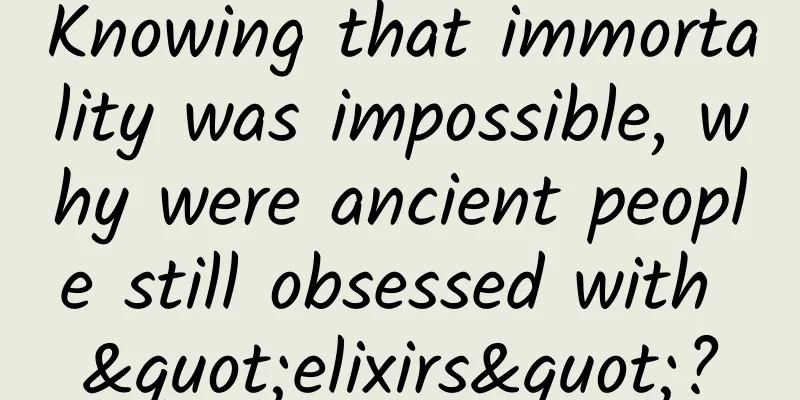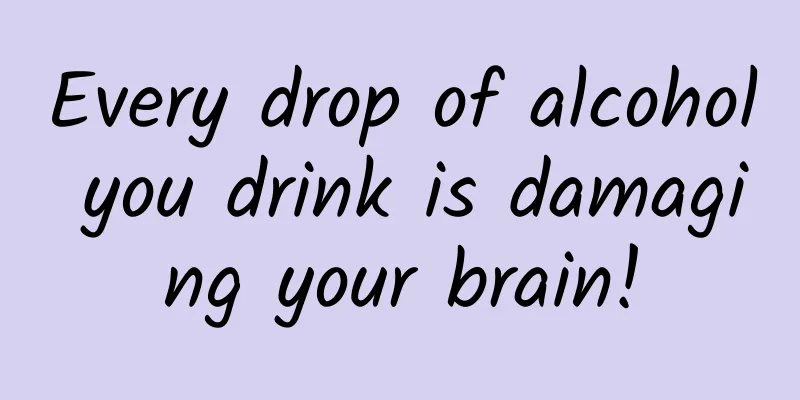Knowing that immortality was impossible, why were ancient people still obsessed with "elixirs"?

|
This article is about 4170 words Reading time: 11 min The rise of elixirs originated from the ancient people's pursuit of immortality. During the Warring States Period, a group of "alchemists" emerged in society. They claimed to understand the "immortal way" and to be able to comprehend the principle of immortality. This statement immediately won the favor of the upper class aristocrats at that time. In order to prove that what they said was true, the alchemists went to the so-called "sea" or "immortal mountain" to collect elixirs for immortality, and the other was to refine elixirs by themselves, which was an early alchemy activity. However, going out to sea to seek the elixir of life is quite risky. Like Xu Fu, who took thousands of boys and girls into the sea to seek immortality, he never returned. More and more alchemists chose to build furnaces to refine elixirs, and the fire in the furnaces began to burn fiercely. Taishang Laojun's alchemy furnace. Source/Still from the 1986 version of "Journey to the West" Purpose: From longevity to health preservation By the Western Han Dynasty, alchemy had become relatively mature, and emperors after that pursued it diligently and enjoyed it. For example, when he was young, Emperor Taizong of Tang despised Qin Shihuang's pursuit of immortality, but when he was old, he was also unable to escape the temptation. He eventually died at the age of 50 after taking the "longevity medicine" made by alchemists in Central India, which made his condition worse. Emperor Xianzong of the Tang Dynasty was a relatively successful emperor in the middle Tang Dynasty. He began to think about immortality when he was in his 40s. As a result, he took elixirs and was poisoned. He could not attend court for several months. The same thing happened to Emperor Muzong and Emperor Wuzong. They were poisoned by elixirs and died in their 30s. The rest of the emperors, such as Emperor Gaozong, Empress Wu Zetian, and Emperor Xuanzong, also took elixirs, but they did not cause serious consequences. The trend of alchemy and taking medicine was at its peak during the Tang Dynasty. Most of the nobles, scholars and celebrities regarded it as a fashion. When they met each other, the greetings basically became like the greeting to Lin Daiyu in the novel "Dream of Red Mansions": "xx, what medicine are you taking recently?" After the Tang Dynasty, the practice of alchemy in the royal family decreased slightly. The most famous one was Emperor Jiajing of the Ming Dynasty. Emperor Jiajing reigned for 45 years, and he did not attend court for more than 20 years. He devoted most of his time and energy to alchemy. He asked his men to collect young virgins and collect their blood to make elixirs. For this purpose, he put these girls in the palace and did not let them eat coarse grains every day. He only let them drink dew and sometimes let them eat mulberry leaves. In the end, several palace maids could not stand it and almost strangled Emperor Jiajing to death. Emperor Jiajing devoted most of his energy to alchemy. Source: Screenshot from the TV series "The Ming Dynasty 1566" In fact, many Tang Dynasty emperors who took elixirs not only did not achieve immortality, but most of them died in their prime, just as Bai Juyi wrote in his poem: "Tuizhi took sulfur, and was never cured of an illness. Weizhi refined autumn stone, and died suddenly before he was old. ... Some died of illness or violent strokes, but none of them lived past middle age." Voices questioning and opposing the use of elixirs gradually grew louder. Elixirs began to shift from the high-level function of immortality to the low-level function of curing diseases. The person who promoted this transformation was the King of Medicine Sun Simiao. As a doctor, Sun Simiao saw the shortcomings of elixirs, but also discovered their merits. He advocated that people should take food before taking medicine, "first understand the source of the disease, know what it is, treat it with food, and if food therapy does not work, then take medicine." In Qianjin Yaofang, he recorded a medicine called Taiyi Shenjing Dan, which was made by refining cinnabar, cinnabar, orpiment, realgar, magnet, and gold teeth, and said that "the ancient immortals used this to save the world, and it was a secret." From the Tang Dynasty to the Song Dynasty, as the function of elixirs quietly changed, more and more doctors joined the alchemy group, and the focus of elixirs fell on "medicine". Therefore, although the trend of taking elixirs in the Song Dynasty remained unabated, people's pursuit was no longer immortality, but longevity. This change in the Song Dynasty has always influenced the following dynasties. For example, Emperor Yongzheng of the Qing Dynasty was also an avid alchemy fan. Because he was not in good health, he set up an alchemy furnace in the Hall of Mental Cultivation to make elixirs. Emperor Yongzheng highly praised the efficacy of elixirs. He not only took them himself, but also recommended them to his ministers. In early July of the eleventh year of Yongzheng's reign, he wrote on a memorial to Minister Tian Wenjing: This elixir is carefully prepared and has extraordinary effects. Take it boldly without any doubt. It is a good medicine that is beneficial and harmless. I know it for sure. The elixir he recommended was called "Ji Ji Dan". Emperor Yongzheng of the Qing Dynasty was also an avid fan of alchemy. Source: Screenshot from the TV series "Yongzheng Dynasty" As the functions of elixirs changed, the raw materials for alchemy also underwent tremendous changes. Raw materials: from stone to herbs There is a saying that the main raw materials for alchemy are five metals, eight stones and three yellows. The five metals are gold, silver, copper, iron and tin; the three yellows are sulfur, realgar and orpiment; the eight stones are different, generally referring to cinnabar, alum stone, saltpeter, mica, quartz, stalactite, red ochre and yellow ochre. In addition, mercury and lead are also the main ingredients for alchemy. The so-called "cinnabar" is actually mercuric sulfide, an inorganic compound of sulfur and mercury. Because it is red, it is called cinnabar. Mercury sulfide. Source/Internet Liu An, the King of Huainan in the Western Han Dynasty, was very keen on alchemy and employed thousands of alchemists to make elixirs. Liu An not only practiced but also summarized his experience and wrote "Huainan Wanbi Shu", which collected various alchemy techniques. According to this book, the raw materials used by his alchemists to make elixirs included mercury, lead, cinnabar, realgar, and so on. In the Eastern Jin Dynasty, the famous alchemist Ge Hong also highly praised the "golden elixir" as a great medicine for health preservation. He believed that although herbs can prolong life, "the elixir cannot be obtained without the medicine for longevity". However, those who take herbal medicine and practice minor techniques can prolong life and delay death... but there is no reason for longevity. Why can taking the golden elixir make people immortal? Ge Hong believed that "the longer the golden elixir is burned, the more wonderful it changes; gold is put into fire, it will not be destroyed after a hundred refinements, and it will be immortal after being buried for a long time. Taking these two things can refine the human body, so it can make people immortal." Therefore, taking the golden elixir is "seeking external things to strengthen oneself". To achieve immortality, one must find an immortal and stable medicine as a support. This explanation is somewhat similar to our saying today that "what you eat is what you need". The famous alchemist Ge Hong praised the "golden elixir" as a great medicine for health preservation. Source/Internet Although no one who took the elixir had ever achieved immortality or become an immortal, the alchemists believed in alchemy. They believed that the reason why the elixir had not yet achieved its effect was because the materials used in the elixir were not good enough. Alchemists began to look for more rare minerals, plants and spices that were not available in the Central Plains or had not yet been discovered. With the development of transportation, some gold, silver, stone, coral, salt green, orpiment and other minerals from Persia flowed into China, and alchemists began to worship foreign things. As long as they had the financial resources to get better quality imported goods, they would not use domestic products. According to the Compendium of Materia Medica, a man named Li Xun in the Tang Dynasty commented: "Sulphur is produced in Kunlun, which is the western part of Persia. The pieces are clear and bright, and the ones without stones are good. It is also produced in Yazhou, Shu, and is very shiny and smooth, but not as good as those imported from ships." It can be seen that in the eyes of alchemists, the quality of quartz from the Central Plains cannot be compared with the high-purity quartz imported from Persia. At the same time, ores such as green vitriol and green salt produced in Persia are also favored by alchemists. Among the elixirs made from these ores, the one with the best effect and the highest evaluation is called "Wushisan", which is made from five minerals: cinnabar, magnetite, blue, realgar and alum. According to historical records, during the Three Kingdoms period, He Yan, a man from Wei, often took Wushisan. He was very handsome and had fair skin. Cao Rui, the Emperor Ming of Wei at that time, suspected that he had applied powder, so he invited him to eat hot soup noodles on a hot day. As a result, He Yan was so hot that he kept wiping sweat, but his face became whiter. Just like many cosmetics today also contain mercury and lead, the arsenic compound arsenic contained in Wushisan is highly toxic, but taking a trace amount can guide digestion, promote blood circulation, and cheer people up. So He Yan advertised Wushisan everywhere, and for a time, this elixir was very popular among the literati of Wei and Jin. He Yan prepares Wu Shi San. Source: A clip from the TV series "Tiger Roars and Dragon Roars" However, using gold and stone as raw materials for alchemy has too many side effects on the human body. Not to mention the emperors of the Tang Dynasty who died of poisoning after taking elixirs, even if they took an overdose of Wu Shi San, they would suffer from dry skin rashes and ulcers at the mildest, or coma and death from myocardial paralysis at the worst. Sun Simiao believed that Wu Shi San should never be taken, and anyone who took it would "have their backs broken and their bodies overturned", so he "preferred to eat wild kudzu rather than Wu Shi San, which is very poisonous and must be used with caution". He improved the formula of Wu Shi San, adding platycodon, siler, ginseng, dried ginger and other ingredients to make it more suitable for human consumption. Under the influence and promotion of Sun Simiao, the practice of "using gold and stone medicines for external elixirs in Wei and Jin Dynasties" gradually changed to "using herbal medicines", and the raw materials for production have changed. The "Shengji Zonglu" compiled by the official in the Song Dynasty said: "When taking herbal medicine, one must choose those with firm branches and leaves, and unchanged shape and quality, such as pine, cypress, and poria cocos. The purpose of this is to prolong life. As for the others, if they do not possess the best of the five elements, then they must have the harmony of the four elements. The meaning is profound. Qian Jin said that the best way to take medicine is to get rid of the three worms first. After the three worms are gone, take herbal medicine. After the herbal medicine is effective, take wood medicine. After the wood medicine is effective, take stone medicine. The fine and coarse medicines are taken alternately. From coarse to fine, the order cannot be disturbed." This view of taking medicine for the purpose of prolonging life and the distinction between fine and coarse herbs and stone medicines became the mainstream thought in the Song Dynasty and even in the dynasties that followed. The use of elixir gradually replaced stone medicines with herbal medicines. The technology of alchemy was also applied to the production process of herbal medicines, and elixir became one of the dosage forms of traditional Chinese medicine. Picture of ancient people making elixirs. Source/Internet Contribution: From Chemistry to Medicine The ancients made alchemy, which accidentally became the earliest chemical experiment. Modern experimental chemistry is generally believed to have originated from alchemy in medieval Europe, and European alchemy came from Arabia, which was passed on from China. In this sense, the ancient Chinese alchemists should be the ancestors of modern chemistry. Take cinnabar as an example. Alchemist Ge Hong discovered that when cinnabar is heated, mercury is decomposed. Then, mercury is combined with sulfur to form black mercuric sulfide, which is then heated and sublimated to return to its original red mercuric sulfide. This process is actually a chemical reduction and oxidation reaction. However, in Ge Hong's eyes, this phenomenon can be linked to longevity. He wrote in "Baopuzi: Golden Elixir": "All plants and trees burn to ashes, but cinnabar is refined into mercury, which changes again into cinnabar. It is far away from ordinary plants and trees, so it can make people live forever." The property of mercury that it can be repeatedly smelted without changing its shape just fits the alchemists' pursuit of immortality, so it is known as the best elixir. In addition, Ge Hong also heated two sulfides, orpiment and realgar, to obtain sublimated crystalline red milk during the alchemy process, and also conducted substitution reaction experiments with iron and copper salts. Although his original intention had nothing to do with chemistry, it actually revealed many chemical changes. Another famous alchemist after him, Tao Hongjing, also realized through alchemy that mercury can form alloys with other metals, and that alchemy raw materials such as yellow ochre and hu powder can be artificially made. In addition, black gunpowder, arsenic elements, and "turning iron into copper" and other revolutions in smelting were also discovered by the ancients during the process of alchemy. During the Sui and Tang dynasties, Chinese alchemy was introduced to Arabia, and then to Western Europe. British scholar Joseph Needham wrote in his book Science and Technology in China: "Chinese alchemy has always been interested in elixirs, which can give people immortality and longevity - a feature of China's early embryonic chemistry, but not in Europe. Most people do not realize that Chinese alchemy has had a huge impact on the West through Arabia." In his eyes, Ge Hong was a "systematizer of alchemy." Alchemy spread to the Middle East and Western Europe, giving rise to modern chemistry, and eventually turned to medicine in China. For example, Sun Simiao recorded the "Flying Mercury Frost Method" in "Qianjin Yifang". Mercury frost is mercuric chloride and calomel, with ancient names "Hongshengdan" and "Baijiangdan", which can be used to treat skin diseases such as scabies and eczema. The chemical agent "Taiyi Shenjingdan" he made, including arsenic oxide and mercuric oxide, can kill protozoa and bacteria, can treat skin diseases when used externally, and can treat relapsing fever and malaria when taken internally. "Wai Tai Mi Yao" compiled by Wang Tao, who was also from the Tang Dynasty, records that there is a kind of high mercuric chloride that has a strong bactericidal and decontaminated effect, which can be used to extract pus, remove toxins, and promote wound healing. In short, the original purpose of alchemists, immortality, is impossible, but from another perspective, as the essence of ancient alchemy, chemical mixture pills have also played a positive role in the medical field. For example, various types of pills such as Hongshengdan, Baijiangdan, and Taiyi Xiaohuandan are still used to treat osteomyelitis, bone tuberculosis, lymph node tuberculosis and other diseases, and play an important role in surgical clinics. Therefore, whether the golden food elixir is beneficial or harmful does not lie in the elixir itself, but in its usage. END Author: Tomato Juice Editor | Zhan Xihui Proofreading | Qiu Sha, Li Dong, Gu Yue Typesetting | Xue Mengyuan *This article is an exclusive article of “National Humanities and History”. |
>>: Red umbrellas and white stems, how did the ancients eat mushrooms?
Recommend
Download the internal VIP course of Dark Horse SEO training
The Dark Horse SEO course is a high-end upgrade o...
To prevent artificial intelligence from betraying humanity, Google, Microsoft and other giants are determined to work together
From "2001: A Space Odyssey" to "T...
10 free photo websites you should visit when operating a business. How many have you used?
I started writing for the official account in Aug...
High-conversion information flow account building routine, just use it directly!
Recently, a friend left a message to complain: Th...
SmartGO, a new brand of Huidian Technology, is launched to promote mobile informatization of government and enterprises
On July 6, the "Taiji Stock Mobile Strategy ...
Is the consecrated Wenchang Pagoda really useful?
There is a reason why the Wenchang Tower has been...
How to make 100 yuan a day, and what side job can make 3,000 yuan a month?
People in the workplace always have the idea and ...
This is Lexus’ new flagship SUV. Can it replace LX?
The Lexus LF-1 Limitless concept car was unveiled...
Why has Proxima Centauri become the “C position” in science fiction works?
Editor's note: Recently, the domestic science...
Tooth-stuck warning! Be careful when buying these types of mangoes!
(Pictures are from the Internet) Mangoes are not ...
What is "ammunition"? Let's take a look at the history of radioactive drugs
With the continuous development of medical diagno...
Tencent's three do's and three don'ts in entering OTT smart TV
In recent days, rumors about Tencent's offici...
11 ways to make money suitable for novices. Just stick to the operation and you can earn over 10,000 yuan a month!
1. Earn money by completing tasks This is very co...
The key to adjusting the Android window soft keyboard: windowSoftInputMode property setting
windowSoftInputMode is an attribute in Android th...
Case Review | How to create a screen-sweeping event with 0 cost?
The case reviewed in this article is an activity ...









